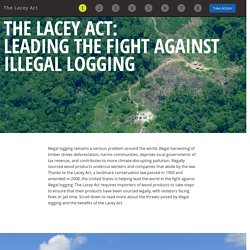

Nature Society (Singapore) Plastic Ocean. Plastic Trash in Oceans Enters Marine Food Chain. Ocean Dumping Before the Marine Protection Research and Sanctuaries Act (MPRSA) Environmental dumping. Environmental dumping is the practice of transfrontier shipment of waste (household waste, industrial/nuclear waste, etc.) from one country to another.

The goal is to take the waste to a country that has less strict environmental laws, or environmental laws that are not strictly enforced. Coastal communities dumping 8m tonnes of plastic in oceans every year. Coastal populations put about 8m tonnes of plastic rubbish into the oceans in 2010, an annual figure that could double over the next decade without major improvements in waste management efforts, scientists warn.

The mountain of plastic litter, including bags, food packaging and toys, was equivalent to five full shopping bags of debris for every foot of coastline bordering nearly 200 countries the team studied. Though researchers have known about plastic waste in the oceans for 40 years, the latest report, published in the journal Science, is the first to attempt a detailed estimate of how much plastic made on the planet finds its way into the oceans. The figures suggest that about 10 to 30 times more plastic debris ends up in the oceans than surveys have found floating about on the surface. In one recent survey, an international team reported more than 5 trillion pieces of plastic are floating in the world’s oceans, collectively weighing nearly 269,000 tonnes. Nuclear Waste Sits on Ocean Floor. More than four decades after the U.S. halted a controversial ocean dumping program, the country is facing a mostly forgotten Cold War legacy in its waters: tens of thousands of steel drums of atomic waste.

From 1946 to 1970, federal records show, 55-gallon drums and other containers of nuclear waste were pitched into the Atlantic and Pacific at dozens of sites off California, Massachusetts and a handful of other states. Much of the trash came from government-related work, ranging from mildly contaminated lab coats to waste from the country's effort to build nuclear weapons. Federal officials have long maintained that, despite some leakage from containers, there isn't evidence of damage to the wider ocean environment or threats to public health through contamination of seafood.
But a Wall Street Journal review of decades of federal and other records found unanswered questions about a dumping program once labeled "seriously substandard" by a senior Environmental Protection Agency official: Cause and Effects of Ocean Dumping. It is a well-known fact that nearly 70% of the earth is filled with water.

Oceans and seas form an indispensable part of our existence. This factor of indispensability has not only helped us tremendously but has also led to us exploiting the oceanic resources without any second thoughts. One of the main causes of pollution of the oceans is ocean dumping. The answer to the question ‘what is ocean dumping’ is quite simple. Dumping involves depositing all the waste materials from factories and industries, tankers and ships and sewerage waste materials into the oceans and seas. Materials like plastic are non-degradable which means they will not be absorbed and recycled. Pollution in the sea. Ocean Pollution. Stephen Palumbi: Following the mercury trail There's a tight and surprising link between the ocean's health and ours, says marine biologist Stephen Palumbi .

National Geographic. The oceans are so vast and deep that until fairly recently, it was widely assumed that no matter how much trash and chemicals humans dumped into them, the effects would be negligible.

Deap East 2001. Population density of the eastern United States.

Click on image for a larger view. Recent studies suggest that the deep ocean bottom supports habitats as diverse as any community on land or in shallow water. The discovery that the deep sea may be every bit as rich as a tropical rainforest comes at a time when land use is at a premium. In the 21st Century, we will have to decide what to do with the vast amount of waste that a growing population -- projected to double from five billion to 10 billion in the next century -- will produce.
The oceans, which cover 70 percent of the Earth's surface, are likely to receive consideration as a waste-management option. Currently, ocean dumping is generally banned worldwide. To some, the deep-sea floor may seem safe from the human disturbances that threaten terrestrial and coastal ocean environments. Studying Deep-sea Biodiversity and Dumping.
The Lacey Act. Threat Illegal logging not only harms plants and animals but also threatens communities by destroying the forests on which they depend and protect, depriving local governments of revenues, and fueling organized crime.

Throughout the world, illegal logging operations encroach on communities, often using the threat of violence, with workers facing dangerous working conditions and human rights abuses. Throughout the past year, we have seen tragic reminders of the threats some communities face. In a remote region near Peru’s border with Brazil, a prominent activist, Edwin Chota, was shot and killed along with three community leaders.
Illegal loggers who have long tried to extract tropical hardwoods in nearby forests are the suspected killers. Benefit By stemming the import of illegally sourced wood products into a major market, the Lacey Act reduces demand for illegally logged timber.